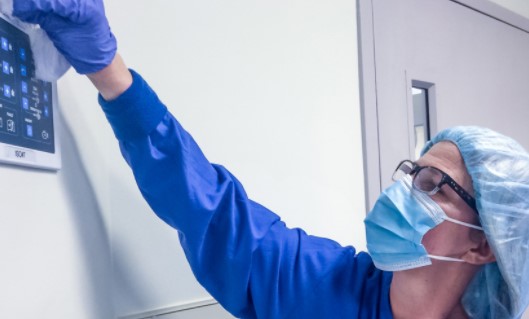Cleanroom Cleaning: How Often Should You Clean/Disinfect?
Cleanrooms are a crucial part of specialized industries like pharmaceutical production, tech manufacturing, and biological research. Specialized equipment and stringent procedures minimize contaminants, direct airflow, and help protect sensitive business operations and the people they serve.
Cleanrooms come with a long list of procedures, from the garb of the people coming and going to special procedures for cleaning and disinfecting. Allowing microbes and stray air particles to accumulate in your cleanroom can defeat the purpose of having one, altogether. As you might expect, the stringent requirements of the cleanroom environment mean that standard disinfection protocols aren’t enough. In fact, they can do more harm than good. Knowing how to keep a cleanroom free of contaminants is crucial.
What is a Cleanroom?
Cleanrooms are used in manufacturing, scientific research, and in any other field where small particles can affect work in a big way. Cleanrooms are essential in aerospace manufacturing, as well as the manufacture of LED displays, solar panels, semiconductors, rechargeable batteries, and more. Research fields like pharmaceuticals, biotech, and life sciences can also require cleanrooms.
For manufacturing cleanrooms and non-sterile medical products, the big threat is airborne particulates. For many research cleanrooms, liquid medicinal product manufacture and others, the big threat is microorganisms. Neither threat is ideal in any sort of cleanroom, but the one you prioritize is going to affect the layout and accommodations of your cleanroom.
Cleanrooms don’t just present a clean environment. They also allow you to control important environmental factors like humidity, temperature, pressure, and flow rate, helping to ensure that your sensitive business operations have the environment that they need.
Cleanrooms have a nested series of rooms in order to protect the central cleanroom. Doors to “dirty” areas must be closed before the door to the cleanroom can be opened. This entry space is usually where people “gown in,” removing personal items and putting on clean protective gear to enter the cleanroom. Once inside, environmental factors like recessed lighting and vents, covered light switches, specialized furniture, and epoxy paint give particles fewer places to hide.
Depending on their purpose, cleanrooms abide by differing sets of standards set by the International Organization for Standardization. These ISO ratings dictate the level of air cleanliness required, and lay out instructions for the design, construction, operation, and even the vocabulary around cleanrooms.
What Are Cleanroom Classifications?
Cleanrooms are classified by their ISO rating. The International Organization for Standardization has two sets of standards.
ISO 14698 is a two-part standard describing principles and methodology for assessing and controlling bio contamination in cleanrooms. ISO 14644 is a 9-part standard describing how to classify, monitor, test, and operate cleanrooms with regards to airborne particulates.
Previously, cleanrooms in the United States had to meet the Federal Standard 209 guidelines. When the ISO 14644 standards came out, the previous standards were retired, but are still in wide use.
The ISO 14644 standards determine how many particles of a certain size can be present in a given cubic meter of air. ISO 9 is just regular room air, while ISO 1 is the most stringently controlled air cleanliness standard. Your industry and the purpose of the cleanroom determine which classification of cleanroom you’ll maintain. Particles are categorized by their size in terms of microns. A micron, also called a micrometer and written as μm, is one one-millionth of a meter. Below, you can see the cleanliness standards for each ISO classification.
Table 1.
ISO 14644-1 clean room standards
| Maximum concentration limits (particles/m3) | ||||||
|---|---|---|---|---|---|---|
| ISO 14644-1: 1999 Classification Number (N) | ≥ 0.1μm | ≥ 0.2μm | ≥ 0.3μm | ≥ 0.5μm | ≥ 1μm | ≥ 5μm |
| ISO 1 | 10 | 2 | ||||
| ISO 2 | 100 | 24 | 10 | 4 | ||
| ISO 3 | 1,000 | 237 | 102 | 35 | 8 | |
| ISO 4 | 10,000 | 2,370 | 1,020 | 352 | 83 | |
| ISO 5 | 100,000 | 23,700 | 10,200 | 3,520 | 832 | 29 |
| ISO 6 | 1,000,000 | 237,000 | 102,000 | 35,520 | 8,320 | 293 |
| ISO 7 | 352,000 | 83,200 | 2,930 | |||
| ISO 8 | 3,520,000 | 832,000 | 29,300 | |||
| ISO 9 | 8,320,000 | 293,000 | ||||
Note. Reprinted from NUFAB Safety & Protocol by Northwestern University Micro/Nano Fabrication Facility (NUFAB), retrieved from https://nufab.northwestern.edu Copyright 2015 by Northwestern University.
Beyond the ISO cleanroom classifications, cleanrooms must also comply with industry-specific and regional standards. Regardless of their stringency, cleanrooms require regular cleaning with specialized equipment in order to maintain function and efficiency.
How to Choose the Right Cleanroom Cleaning Products
Even if all of the cleanroom equipment is working perfectly and everyone follows the garbing and hand-washing procedures they’re supposed to, your cleanroom will still need regular cleaning in order to minimize the presence of stray biomatter and air particles.
Cleanroom cleaning requirements are specific, and only certain equipment is allowed. The equipment and procedures followed may vary depending on the ISO classification of the cleanroom. Here are some things you can generally assume that you’ll need:
Personal Protection:
- Disposable gloves
- Lint-free shoe covers
- Safety glasses
- Surgical masks
- Hair and beard covers
- Gowns/frocks
Never introduce cleaning agents into a cleanroom that aren’t specifically designated for cleanroom use. Your cleaning products should work for a broad spectrum of microbes and be efficient and safe to use as possible. Your products will ideally be fast-drying and not leave behind any residues. You’ll need to rotate your cleaning agents out every couple of weeks to prevent resistant microflora from developing, and to diminish residue buildup. For higher-grade cleanrooms, you’ll actually need your disinfectants and cleaning chemicals to be validated in pharmaceutical facilities and filtered/sterilized.
You’ll also need a good detergent. You’ll need a non-ionic, non-foaming solution that’s compatible with the disinfectant. Finally, you’ll need to be careful with your cleaning materials themselves. Never use powders, rags, or scrubs. Cleanroom-specific mops will be made of materials like woven polyester which will limit shedding or tearing. (Paper or cloth towels will leave fibers behind, contaminating your cleanroom instead of cleaning it.)
Cleanroom Cleaning and Disinfecting Procedures
EVERY DAY:
- Clean and garb up in accordance with your standard cleanroom procedures.
- Use a damp cleanroom mop and distilled water to mop the floors daily, then vacuum them dry. Do this before the shift begins.
- Vacuum the ceilings daily.
- Vacuum the walls daily.
- Wash the windows and pass-throughs daily and dry them with lint-free 70% IPA wipes.
- Use deionized water to scrub all surfaces, floors, and walls.
- Use a multi-bucket mopping system (double-bucket or triple-bucket) to separate clean and dirty water and avoid cross-contamination.
WEEKLY:
- Wash the ceilings with a damp sponge and distilled water weekly, then vacuum them dry.
- Wipe the walls with a cleanroom sponge and vacuum them dry.
- Mop the floors with a cleanroom agent and distilled water, then vacuum them with a HEPA filter vacuum.
- Clean light lenses and troffers with a damp sponge and distilled water, then vacuum them dry.
AS NEEDED:
- As needed, wash the ceilings with detergent and distilled water to remove deposits.
- Change the sticky mats as needed, frequently.
You should disinfect regularly. As with cleaning, disinfection should use a multi-bucket system to avoid cross contamination. You should only use cleanroom-approved disinfectants and materials. Disinfect all surfaces, potentially including the ventilation system grates.
One solution to consider is electrostatic disinfection. While this may not be ideal in some cleanrooms where electrostatic charge is a possible vector of contamination, it is perfect for others. Electrostatic disinfection uses an ionic charge to bind disinfectants to surfaces, most of which are positively charged. Electrostatic disinfection helps to ensure thorough destruction of microbes, even in hard-to-reach places where ordinary cleaning methods may not do a thorough job.
How Often Should You Clean/Disinfect?
The frequency of disinfection will depend on your cleanroom classification. Higher-grade cleanrooms may need more frequent, vigorous cleaning and disinfection than lower-grade rooms, but both should have a regular cleaning schedule. Continually evaluating the effectiveness of your cleaning and disinfecting protocols can help you determine how often disinfection is necessary.
Keeping a cleanroom appropriately disinfected is everyone’s job. From your regular staff members to your janitorial personnel, every single person who enters that room has a part to play in keeping it appropriately free from contaminants.
Professional cleaners who have the experience and equipment needed for cleanroom maintenance can take a lot of the stress and worry out of caring for these sensitive environments. In a cleanroom, every decision from the type of water used to how many buckets your cleanroom-specific mop should have counts. Professional cleaners who are used to these decisions and are equipped to execute on them can help you maintain a sterile environment with less worry on your part.
Resources
- Northwestern University Micro/Nano Fabrication Facility (NUFAB) “NUFAB Safety & Protocol” Northwestern.edu. Accessed October 2020. https://cpb-us-e1.wpmucdn.com/sites.northwestern.edu/dist/f/666/files/2015/10/NUFAB-Safety-Protocol-Policy-10gsrfd.pdf










